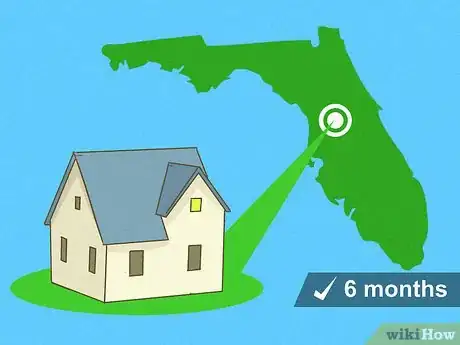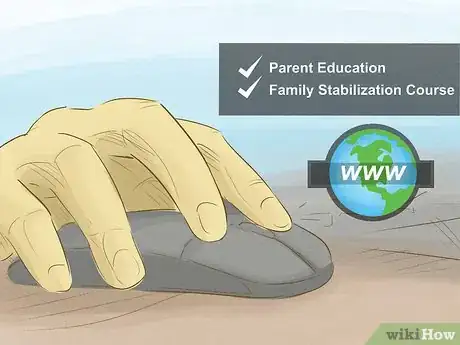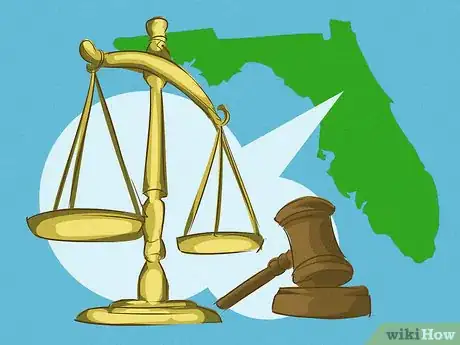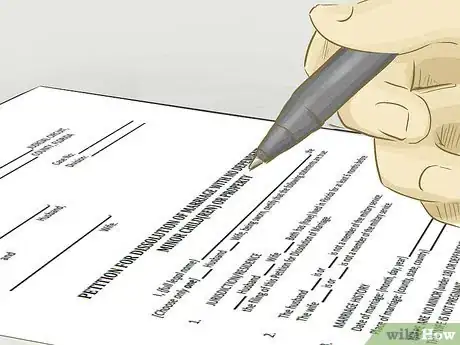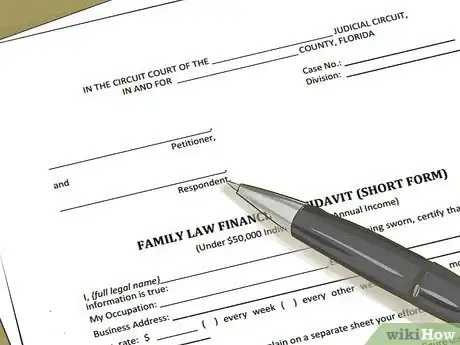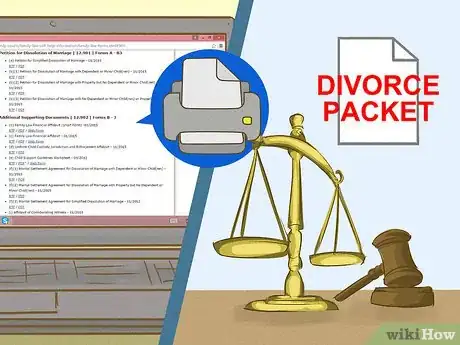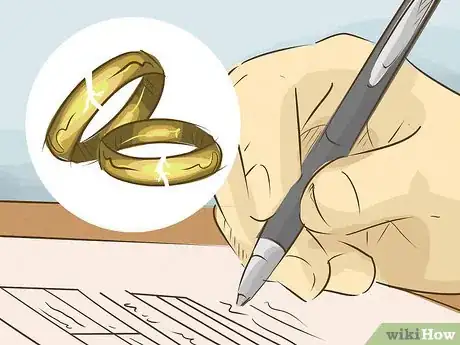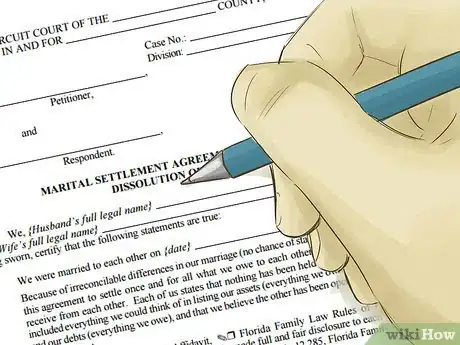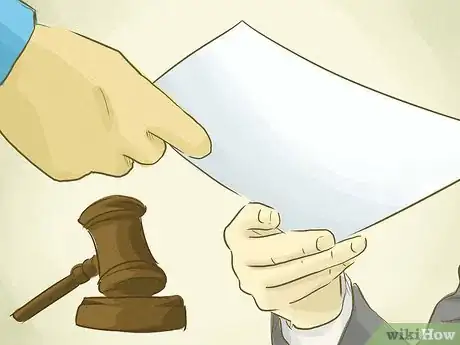This article was co-authored by Clinton M. Sandvick, JD, PhD. Clinton M. Sandvick worked as a civil litigator in California for over 7 years. He received his JD from the University of Wisconsin-Madison in 1998 and his PhD in American History from the University of Oregon in 2013.
There are 9 references cited in this article, which can be found at the bottom of the page.
wikiHow marks an article as reader-approved once it receives enough positive feedback. In this case, 95% of readers who voted found the article helpful, earning it our reader-approved status.
This article has been viewed 209,264 times.
In Florida, divorce is technically called “dissolution of marriage,” and Florida residents have 2 options: either filing for regular dissolution of marriage or using the simplified version. The simplified method, however, is only available for those without children. Before filing to have their marriage dissolved, Florida couples must satisfy various requirements.
Steps
Satisfying the Requirements
-
1Be sure the marriage is irretrievably broken. Florida no longer requires “fault” for a divorce. Instead, both parties must claim that the marriage is “irretrievably broken.”[1]
- Fault may be considered later, when deciding alimony, equitable division of marital property, and child custody.
-
2Satisfy residency requirements. In order to get a divorce in Florida, one party must have been a resident of the state for the preceding 6 months.[2]Advertisement
-
3Take an online class. Couples who have children must take an online course before filing for divorce. Sometimes the children must also take a course specially designed for them.[3]
- One recommended Parent Education and Family Stabilization Course costs $19.95. You should expect to pay a fee for the class.[4]
- If you are getting a Simplified Divorce, then you do not have to take this class (because a requirement of a Simplified Divorce is that you have no children).
- You should contact the court clerk with questions about the specific course approved for your county.
Preparing for Divorce
-
1Think about hiring a lawyer. A divorce is a stressful experience, and an experienced family law attorney can help relieve your stress by handling all of the paperwork necessary to file for divorce. You can find a reputable family law attorney by visiting the referral service available at the Florida Bar Association’s website.
- Florida attorneys can be certified as specialists in Marital and Family law. You should look at an attorney’s website to see if he or she is certified as a specialist.
- If costs are a concern, be aware that Florida courts are empowered to award attorney’s fees to a party, particularly when the spouses are in different financial positions.[5] If you have far less financial resources than your spouse, you may be able to qualify for this fee shifting.
- A Simplified Divorce is designed so that no attorney is necessary, though you may have one if you prefer. Because no children are involved in a Simplified Divorce, you may only want to speak to an attorney if you have questions about how to divide marital property.
-
2Come to an agreement on child custody. If possible, you and your spouse should attempt to meet and decide on child custody. A joint stipulation on custody issues will be honored by the court if the court finds that it is in the best interest of the child.
- In the absence of an agreement, the court will have to hold a trial. A trial can be time-consuming, expensive, and stressful. Also, people’s positions tend to harden throughout a trial, making it difficult to work with the other parent after the trial has ended and custody has been awarded.
-
3Draft a marital settlement agreement. Before filing for a “simplified divorce,” you will need to have come to agreement on a marital settlement. Marital property includes real estate, cars, retirement benefits, stocks, bonds, cash, bank accounts, and anything else of value.[6]
- The division of property must be “equitable.” This means that the property should be divided fairly, not necessarily equally. A court will decide whether your division is equitable by considering the duration of the marriage, the contribution of each spouse to the marriage, and the economic circumstances.[7]
- A form approved by the Florida Supreme Court is here.
Filing for Regular Dissolution of Marriage
-
1Locate the correct court. You must file in the circuit court for the county where you last lived as a married couple or in the county where either party currently resides.[8]
-
2Draft a dissolution of marriage petition. You initiate divorce proceedings by filing a petition in the court. In the petition, you ask the court for the divorce. Either spouse may file.[9]
-
3Fill out additional forms. You will also have to fill out an Affidavit of Corroborating Witness, a Marital Settlement Agreement, Notice of Social Security Number, Family Law Financial Affidavit, and Certificate of Compliance with Mandatory Disclosure.
-
4File the petition. You (or your attorney) should take the petition as well as any supporting documentation and file it with the clerk of court. You will also have to pay a fee, which varies depending on the court.
- For example, the fee in Hillsborough County is $408.00.
- If you cannot afford the filing fee, ask for an Application for Determination of Civil Indigent Status from the clerk.[11]
-
5Serve notice on your spouse. You must give your spouse notice that you have filed a petition for dissolution of marriage so that he or she can answer the petition within 20 days.[12] The most common methods of service are personal service and constructive service. You cannot serve by mail or hand delivery.
- If you know where you spouse is, you should serve the papers personally. You should fill out a Summons and a Process Service Memorandum. You will need your spouse’s home and work address.
- You will then need to ask the clerk to help schedule service by the sheriff. If your spouse lives in the same county as where the court is located, then you can have the local sheriff serve notice for a fee. The fee can only be paid with cashier’s check or a money order. You must also include a self-addressed stamped envelope. After service, the sheriff will send proof of service to you.
- If your spouse lives in a different county, then the clerk will send the papers to the sheriff in the other county.
- Personal service is recommended. Constructive service (by publication) is available if you cannot locate your spouse or if he or she lives in a different state. Talk to the clerk, as your remedies will be limited if you do not personally serve the spouse.
Using the Simplified Divorce Procedure
-
1Meet the prerequisites. To use the simplified divorce procedure, you must meet specific requirements. If you cannot satisfy the requirements, then you must file for regular divorce. The prerequisites are:[13]
- You and your spouse agree the marriage cannot be saved.
- You cannot have any minor or dependent children from the marriage, and the wife cannot be pregnant.
- You and your spouse have worked out how you will divide marital property as well as financial liabilities.
- Neither spouse is seeking alimony.
- One party must have been a Florida resident for 6 months.
- You are willing to give up your right to a trial and an appeal.
-
2Pick up a divorce packet. You should visit your court’s Self-Help center and purchase a divorce packet. This packet has all of the forms you will need. It should cost around $65.
- The Self-Help center keeps regular business hours (Monday-Friday, 8:00 am-4:30 pm). Call your court for specific details.
- You must bring a photo ID each time you visit the center.
- Forms are also available free of charge here.
-
3Fill out the divorce forms. You can have someone at the Self-Help center review your forms, though no one at the center will fill them out for you.
- After having them reviewed, you should make copies for each spouse.
-
4Fill out a simplified marital settlement agreement. A form approved by the Florida Supreme Court for simplified divorces is located here.
- In this form, you will list the property (and its value) that each spouse will receive. Property includes cash, stocks, real estate, automobiles, retirement plans, and life insurance benefits.
- Each party must sign this document in front of a notary.[14] Although you do not have to sign it together, you can both sign it in front of a notary at the court house when you go to file your petition for dissolution of marriage.
- The agreement does not operate to transfer title. If you need to transfer title to property (such as land), then you will need to get the deed.[15]
- Similarly, the marital settlement agreement does not change whose name any spousal debts (such as a mortgage) are in.
-
5File the divorce application with the clerk of court. Both spouses must go to the clerk’s office in order to file. Be sure to each bring a valid photo identification.
- Check with the court clerk whether both spouses must go together. Miami-Dade requires that you both attend to file the petition together.[16] However, this is not a requirement of the Florida Supreme Court,[17] so requirements may vary by county.
- Supply a witness to corroborate residency. The witness must have a valid photo identification. The witness must corroborate that at least one partner has lived in Florida for at least six months. A notarized certificate from the witness, rather than a personal appearance, is acceptable.
-
6Pay a filing fee. The cost of a simplified divorce can vary slightly by county, but should run about $408. Call ahead to find out acceptable methods of payment.
References
- ↑ http://www.floridabar.org/tfb/tfbconsum.nsf/48e76203493b82ad852567090070c9b9/50c0b911a9cb28fd85256b2f006c5ba9
- ↑ http://www.floridabar.org/tfb/tfbconsum.nsf/48e76203493b82ad852567090070c9b9/50c0b911a9cb28fd85256b2f006c5ba9
- ↑ http://www.floridabar.org/tfb/tfbconsum.nsf/48e76203493b82ad852567090070c9b9/50c0b911a9cb28fd85256b2f006c5ba9
- ↑ http://www.floridaparentingclass.com/
- ↑ http://www.sandytfox.com/lawyer-attorney-1444238.html
- ↑ http://www.floridabar.org/tfb/tfbconsum.nsf/48e76203493b82ad852567090070c9b9/50c0b911a9cb28fd85256b2f006c5ba9
- ↑ http://www.floridabar.org/tfb/tfbconsum.nsf/48e76203493b82ad852567090070c9b9/50c0b911a9cb28fd85256b2f006c5ba9
- ↑ http://www.floridabar.org/tfb/tfbconsum.nsf/48e76203493b82ad852567090070c9b9/50c0b911a9cb28fd85256b2f006c5ba9
- ↑ http://www.floridabar.org/tfb/tfbconsum.nsf/48e76203493b82ad852567090070c9b9/50c0b911a9cb28fd85256b2f006c5ba9
- ↑ http://www.flcourts.org/core/fileparse.php/533/urlt/901b1.pdf
- ↑ http://www.flcourts.org/core/fileparse.php/533/urlt/901b3.pdf
- ↑ http://www.floridabar.org/tfb/tfbconsum.nsf/48e76203493b82ad852567090070c9b9/50c0b911a9cb28fd85256b2f006c5ba9
- ↑ http://www.flcourts.org/core/fileparse.php/293/urlt/901a.pdf
- ↑ http://www.flcourts.org/core/fileparse.php/293/urlt/902f3.pdf
- ↑ http://www.flcourts.org/core/fileparse.php/293/urlt/902f3.pdf
- ↑ http://www.miami-dadeclerk.com/families_divorce_simple.asp
- ↑ http://www.flcourts.org/core/fileparse.php/293/urlt/901a.pdf
About This Article
To file your own divorce in Florida, you’ll need to agree on how your shared property and finances will be divided. It will help to hire a lawyer, but if you can come to an amicable agreement, you can file on your own. If you have children, you’ll also need to take an online course before you file for divorce. Once you’ve reached an agreement, file a dissolution of marriage petition, which you can get from your local court, and pay the filing fee. You’ll also need to file an Affidavit of Corroborating Witness, a Marital Settlement Agreement, Notice of Social Security Number, Family Law Financial Affidavit, and Certificate of Compliance with Mandatory Disclosure. However, if you don’t have any children and you agree on how your property will be divided, you can get a simplified divorce packet from your court. For more tips from our Legal co-author, including how to agree on child custody, read on.

